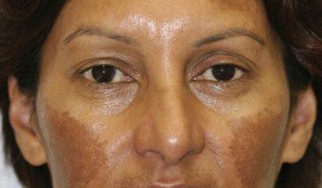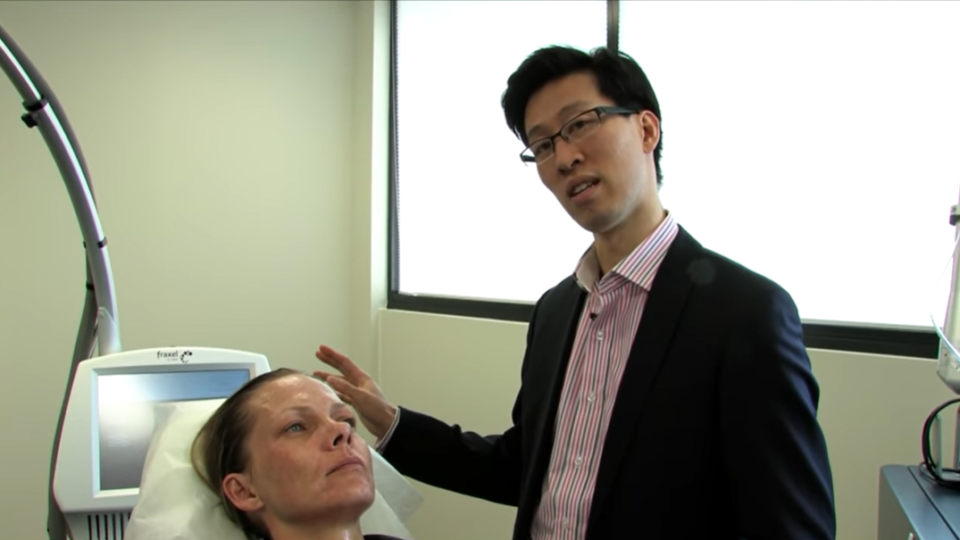I have melasma hormonal pigmentation. How can I treat it?
What is melasma skin pigmentation?
Melasma is a form of facial pigmentation stimulated by UV radiation and your natural circulating oestrogens. This form of skin pigmentation is stimulated by oestrogen from the contraceptive pill, pregnancy and hormone replacement therapy (HRT).
Melasma skin pigmentation usually affects women more than men and can be found on sun-exposed areas of your face including:
- Cheeks
- Upper lip
- Forehead, and
- Bridge of the nose.
Most people who have hormonal skin pigmentation tend to have a more olive or dark complexion. Melasma can’t be permanently removed or cured, but it can be treated to minimise its effects.

Is there a hormonal reason for melasma?
Before the skin pigmentation on your face is treated, it’s important to determine if there are any reasons why your pigmentation has worsened. This will be discussed during your consultation. For example, a steep rise in oestrogen levels will stimulate excess melanin production – which results in hyperpigmentation of your skin.
Some hormonal factors which can contribute to melasma include:
Pregnancy
If you have been pregnant or had friends who are pregnant, you may have noticed dark, brown and blotchy patches of skin on your upper lips, forehead and cheeks. Melasma is present in 15% – 50% of expectant mothers. And if family members have had this skin pigmentation, it’s more likely you will also develop melasma.
If you are pregnant or breastfeeding we do not perform skin treatments targeted at melasma, however you can adopt a preventative approach. During a consultation with our practitioners you can receive a tailored skin care prescription.
Oral contraceptives
If you’re taking oral contraceptives and notice blotchy brown patches appearing on your face, it’s recommended to consult with a practitioner. Call us on 1300 863 824 to book your consultation.
Hormone Replacement Therapy and Melasma
If you are on hormone replacement therapy (HRT) and develop blotchy, brown skin symptoms of melasma, you will need to take extra care to:
- Use sunscreen throughout the day
- Stay out of the hot midday sun
- Wear a hat
- Consult with one of our practitioners about an appropriate melasma pigmentation treatment for your skin.
Exposure to UV rays
The appearance of melasma on your face can turn darker with exposure to the sun. If you’re pregnant, on the contraceptive pill or hormone replacement therapy, you will need to apply sun protection cream in the morning and throughout the day. It’s also important to regularly wear a hat and sunglasses.
Melasma skin pigmentation treatment at Victorian Cosmetic Institute
When you’re looking for treatment options for your skin pigmentation, we suggest you consult with a trained practitioner.
Treatments are a long-term commitment with no quick fixes, but we offer multiple treatments and skin care options. Consulting with us is the first step to getting your melasma treated.
Find out more about our melasma hormonal pigmentation treatments here
To schedule a consultation to discuss your facial skin pigmentation call us on 1300 863 824.
Melasma skin pigmentation treatment when pregnant or breastfeeding
While we can treat hormonal skin pigmentation that has been caused by your pregnancy, the treatments aren’t suitable if you’re pregnant or breastfeeding. Skin care with the appropriate active ingredients is recommended whilst pregnant or breastfeeding.
A consultation is required to assess your level of melasma pigmentation and prescribe appropriate skin care for you. Phone our friendly Customer Care team on 1300 863 824 or book your consultation online.

